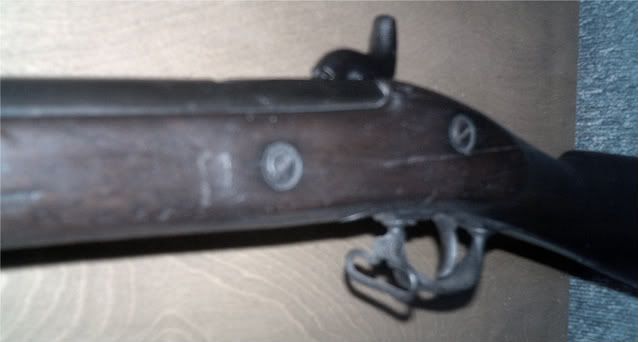I got ahold of a digital camera last night (not mine, so don't complain about the photos, it doesn't have a macro setting for closeup shots) so I took a few photos of my most treasured firearm. I just have to show it off.
The Story:
What I heard from my grandfather is that this rifle came from his grandfather, who got it from a relative (an uncle, I believe it was) who had brought it home from the war. My grandfather's grandfather hunted with it until something in the mechanism broke (the hammer is under spring tension, but will not lock back), and after that it has hung on many generations of walls and been played with by many generations of childern (my grandfather, my uncle, and myself included). All that has been done to it since it was last used for hunting has been to wipe it down with a little oil from time to time and run an oiled patch down the bore now and then. That seems to have worked well, I think I'll keep up that preservation technique.
The Rifle:
Appears to be an 1861 pattern rifle-musket.
Sideplate says:
US (with eagle and shield in between the letters)
Amoskeag Mfg Co
(unreadable) NH
behind the hammer is stamped 1863
It is missing the rear sight and has a very old repair of a crack in the stock. It seems to have been fixed by drilling a hole and filling it with a peg and some sort of tar or resin (4th photo). However they did it, it has held up well.
From the research I have done, this seems like it could be a fairly rare 1861 as only 10,000 were ordered from this maker. I have not been able to find any detailed info about Amoskeag, though, so if any of y'all know anything, please share.
I would never sell this rifle. Ever. But I guess I am curious as to its value for insurance if nothing else. If any of y'all know what these are usually valued at, that would be nice to know.
Do not suggest that I would ever sell this rifle in your posts, it will be taken as a severe personal insult.
If anyone knows anything about this rifle or gunmaker, please share. I am anxious to learn all I can.




The Story:
What I heard from my grandfather is that this rifle came from his grandfather, who got it from a relative (an uncle, I believe it was) who had brought it home from the war. My grandfather's grandfather hunted with it until something in the mechanism broke (the hammer is under spring tension, but will not lock back), and after that it has hung on many generations of walls and been played with by many generations of childern (my grandfather, my uncle, and myself included). All that has been done to it since it was last used for hunting has been to wipe it down with a little oil from time to time and run an oiled patch down the bore now and then. That seems to have worked well, I think I'll keep up that preservation technique.
The Rifle:
Appears to be an 1861 pattern rifle-musket.
Sideplate says:
US (with eagle and shield in between the letters)
Amoskeag Mfg Co
(unreadable) NH
behind the hammer is stamped 1863
It is missing the rear sight and has a very old repair of a crack in the stock. It seems to have been fixed by drilling a hole and filling it with a peg and some sort of tar or resin (4th photo). However they did it, it has held up well.
From the research I have done, this seems like it could be a fairly rare 1861 as only 10,000 were ordered from this maker. I have not been able to find any detailed info about Amoskeag, though, so if any of y'all know anything, please share.
I would never sell this rifle. Ever. But I guess I am curious as to its value for insurance if nothing else. If any of y'all know what these are usually valued at, that would be nice to know.
Do not suggest that I would ever sell this rifle in your posts, it will be taken as a severe personal insult.
If anyone knows anything about this rifle or gunmaker, please share. I am anxious to learn all I can.




Last edited:
